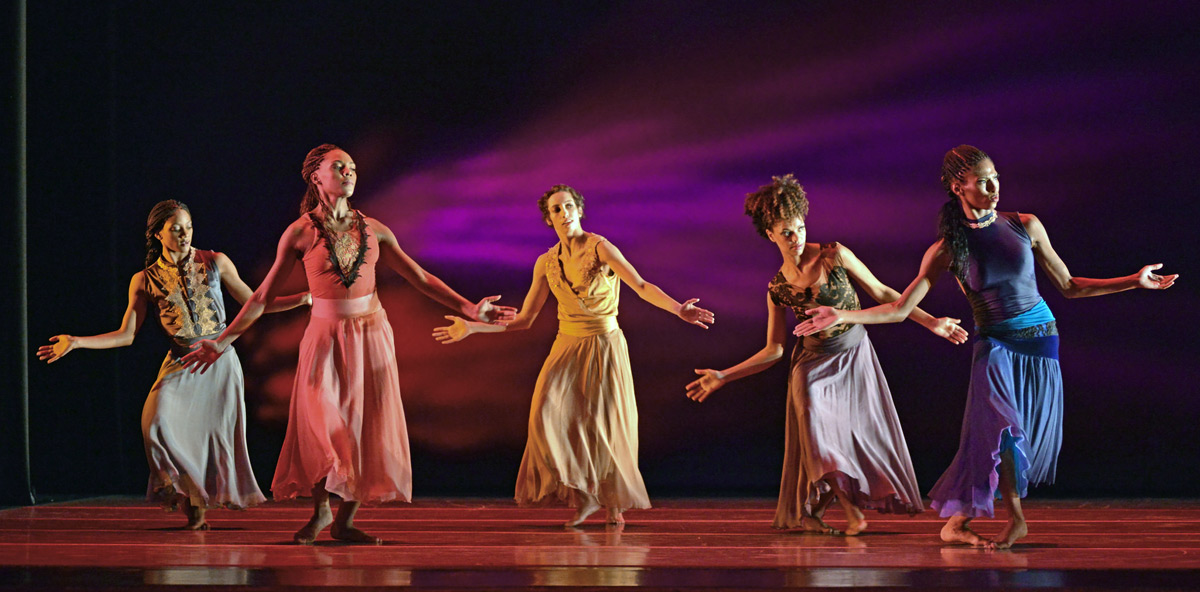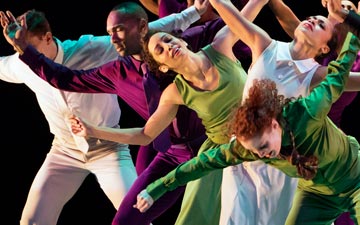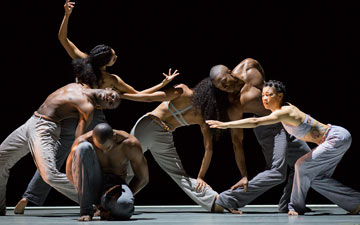
© Foteini Christofilopoulou. (Click image for larger version)
Alvin Ailey American Dance Theater
Programme A: Exodus, Four Corners, After the Rain pas de deux, Revelations
Programme B: Open Door, Piazzolla Caldera, Revelations
★★★★✰
London, Sadler’s Wells
6, 7 September 2016
Gallery of pictures by Foteini Christofilopoulou Exodus, Awakening
Gallery of pictures by Dave Morgan Four Corners, Open Door
www.alvinailey.org
www.sadlerswells.com
Dance Consortium Uk tour 20 Sept – 19 Oct 2016
Alvin Ailey’s dancers need to be incredibly versatile. Well over 200 works by more than 90 choreographers have been created since the company’s foundation in 1958. Robert Battle, only its second director since Ailey’s death in 1985, has been widening its repertoire since his appointment in 2011 to include works by Wayne McGregor, Christopher Wheeldon and Aszure Barton, as well as commissions from veteran African-American choreographers, such as Rennie Harris and Ronald K. Brown. Every programme in the UK season concludes with Ailey’s Revelations, the company’s signature finale from 1960.
Recent works in the first mixed bill at Sadler’s Wells include Harris’s Exodus and Brown’s Four Corners, both new in 2015. Exodus employs Harris’s street dance idiom, modified to suit Ailey’s dancers and his theme of loss and redemption. It opens with downcast bodies packed close together as if in the hold of a slave ship, illuminated by hazy beams of light from a grille above. A tall, bare-chested figure (Jamar Roberts) moves among them, stirring them into life. A shot rings out and a man falls, cradled in the arms of a mourning woman.

© Foteini Christofilopoulou. (Click image for larger version)
Others tremble, raising their arms in appeals for salvation, before setting off in unison in hip-hop moves, feet swivelling and hips swinging, to a variety of vocal music. They are dressed in every day clothes and sneakers, celebrating being alive but also expressing rage and frustration as their dancing quickens. Another shot is fired. Roberts raises up the wounded man (Matthew Rushing), a Lazarus back from the dead. One by one, dancers return from a steady parade across the back of the set, this time dressed all in white. They have become blessed spirits, passing into a different dimension under the guidance of Roberts, the Christ figure.
Harris calls him Prometheus, bringer of life and death. He has a solo, a magical figure alone on stage before the angelic hip-hoppers return to surround him. Rushing, the last person wearing street clothes during his resurrection, falls again from shotgun fire at the end. After the cast have solemnly taken their bows, Rushing, in white, joins them as they turn their backs and walk into the dark. Like Revelations, Harris’s piece is both a protest at the treatment of African-Americans and an assurance of faith that they will come through. It’s an inspired use of hip-hop in a spiritual (and political) context, danced with urgent commitment.

© Dave Morgan. (Click image for larger version)
Ronald K. Brown’s Four Corners also deals with seekers of a cosmic dimension. Four principal figures in purple, Linda Celeste Sims and her husband, Glenn Allen Sims, Belen Pereyra and Rushing, apparently represent the mythical four corners of the world, holding the four winds. Brown’s source is the lyrics to Lamentations, vocal music by his friend, poet and playwright Carl Hancock Rux. (I found this information from the company website: the programme provides no information about the context of the works.) Three men enter, distraught, to be consoled by four women. Their movements are a mixture of African and modern dance, torsos held forward, hips churning and feet pulsing. Although the style appears earthy, the Ailey dancers’ impetus is always upwards, ready to swirl and leap away from gravity.
After ensemble dances to lyrics by Rahsaan Roland Kirk chanting ‘Volunteered slavery has got me on the run’, the music calms to a West African lullaby and the group finds solace under the influence of the four ‘angels’. Since this narrative journey isn’t obvious, the choreography seems bafflingly repetitive.

© Dave Morgan. (Click image for larger version)
Before Revelations comes Wheeldon’s After the Rain pas de deux to Arvo Part’s mesmerising music. Originally created on slight, sinewy Wendy Whelan and sturdy Jock Soto of New York City Ballet, it is also in the Royal Ballet’s repertoire as part of a one-act ballet. As danced by Akua Noni Parker and Jamar Roberts, the duet becomes one of equals, rather than a man yearning after a wraith or an elusive muse. Parker doesn’t float – she’s lifted. A powerful woman, she surrenders at the end, sinking from an ungainly acrobatic position that mars the lyrical pas deux.
Revelations is always a joy, however often one sees it. Ailey’s choreography, influenced by his mentor, Lester Horton, and Martha Graham, is a reminder of how potent that modern dance technique could be. The company continue to do it justice, making roles created by their famous predecessors entirely their own.
The star of the second programme (apart from Revelations) is Paul Taylor’s Piazzolla Caldera, made for his own company in 1997 and taken into the Ailey repertoire last year. It follows after Ronald K. Brown’s recent Open Door to Cuban music recorded by Arturo O’Farrill’s Afro-Latin Jazz Orchestra. Brown mixes salsa, mambo and danzon with modern jazz styles, catchy and fun. Men strut, women are sassy, the sexes dancing side by side or in their own space until the finale, when they get together in couples.

© Dave Morgan. (Click image for larger version)
It’s an engaging piece about nothing more than the joy of dancing. Once Piazzolla Caldera gets going, however, you realise you’re in the hands of a choreographer in a different league. This is feral, not social, dance. Men and women start out as confrontational tribes until they negotiate personal encounters to tango music by Astor Piazzolla and Jerzy Peterburshsky. This is the only time in the first two mixed bills that (with the exception of After the Rain pas de deux) the dancers engage in intricate partnering. Lifts are daring, sexy, revealing.
Women are available on their terms, as lustful as the men. Linda Celeste Sims finds herself rejected by six men, remaining lonely and disconcerted as couples waltz together behind her wistful solo. She’s caught up in a trio, but the men prefer each other’s company, drunk or otherwise. There’s a risky foursome, with Rachael McLaren and Jamar Roberts combining with Daniel Harder and Michael Francis McBride. Taylor is a master manipulator of numbers, entrances and exits, contrasting rhythms. Everyone succumbs to a tango delirium, as woozy as the orchestra’s bandoneons on the soundtrack. At the end, the entire group collapses, except for solitary Sims. Then she crashes onto her back, a sacrificial victim, as the others rise, undaunted.

© Paul Kolnik. (Click image for larger version)
Taylor’s dark perspective on the human condition is counteracted by the return of Revelations and its affirmation of faith in salvation. It’s finale, ‘Rocka my soul in the bosom of Abraham’, is irresistible, guaranteeing a reprise to satisfy the audience’s reluctance to let the dancers go.

















You must be logged in to post a comment.